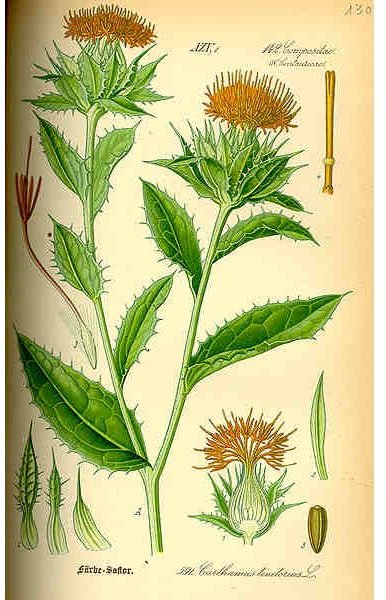Learn the Facts About Safflower Oil Health Benefits
Safflower, Catharmus tinctorius, is an annual, herbaceous, thistle-like plant belonging to the daisy or sunflower family (Asteraceae). It is cultivated for its seeds, which are rich in vegetable oil containing a high concentration of monounsaturated fatty acids (oleic acid) and polyunsaturated fatty acids (linoleic acid). There are two varieties of safflower: one high in polyunsaturated fatty acids and the other high on monounsaturated fatty acids. Besides oleic and linoleic acids, safflower oil also contains other essential nutrients like amino acids and vitamin E.
Safflower oil is used in cooking, in making salad dressing and margarine, in making cosmetics, and in manufacturing paints. It is also used as a food supplement, available in capsules. It is considered as high quality oil because of it contains essential fatty acids that are beneficial to the body. Continue reading to learn the different safflower oil health benefits.
Safflower Oil Linoleic Acid Health Benefits
Linoleic acid is an unsaturated omega-6 fatty acid and considered as one of the essential fatty acids that we should ingest because our body requires it for various biological processes. It is not manufactured or synthesized inside our body, so we really need to eat foods containing the fatty acid. Deficiency in linoleic acid can cause dry hair, hair loss, poor wound healing, and other diseases. Safflower oil is a good source of linoleic acid for our dietary needs. Linoleic acid has many benefits to our body:
- Linoleic acid is a precursor molecule for the production of other essential fatty acids needed by our body, including arachidonic acid, which is involved in muscle growth, brain development, and inflammation.
- Linoleic acid is an important structural component of cell membranes.
- Linoleic acid supplementation has been found effective in reducing total body fat in obese individuals.
- Several studies suggest that linoleic acid might help prevent cancer.
- Linoleic acid can help reduce blood cholesterol levels.
- Linoleic acid helps reduce inflammation and pain.
- Taking linolec acid can help improve the symptoms of eczema.
- Preliminary studies show that linoleic acid help reduce high blood pressure especially when taken with omega-3 fatty acids.
- According to a few studies. linoleic acid can help reduce bone loss associated with osteoporosis.porosis.
Safflower Oil Oleic Acid Health Benefits
Oleic acid is a colorless monounsaturated fatty acid. Like linoleic acids, it has also health benefits:
- Like linoleic acid, oleic acid is also an important component of cell membranes .
- Oleic acid may help prevent the onset of adrenoleukodystrophy, a rare genetic disease that affects the brain and adrenal glands.
- Oleic acid boosts the immune system by enhancing the production of antioxidants, compounds that help eliminate harmful free radicals in the body.
- Oleic acid helps in lowering the levels of low density lipoprotein (LDL) or bad cholesterol in the body.
- Studies suggest that oleic acid promotes good memory by maintaining the health of neurons.
- Oleic acid can help reduce the risk of breast cancer according to several studies.
- Like linoleic acid, oleic acid has anti-inflammatory properties too.
- Studies show that eating vegetable oils high in oleic acid can help lower the risk of developing ulcerative colitis by 90%.
- According to a study, oleic acid can lower insulin resistance in the general population.
References
- Omega-6 fatty acids. University of Maryland Medical Center.
- Sunflower and safflower. Economic Botany. UCLA.
- Safflower. Purdue University.
- Monounsaturated Fats. American Heart Association.
- Polyunsaturated Fats. American Heart Association.
- Fats and oils. Better Health Channel.
- Scimeca, J.A. Et al. 2000. Potential Health Benefits og Linoleic Acid. Journal of the American College of Nutrition.
Image Source
• https://upload.wikimedia.org/wikipedia/commons/a/a0/Illustration_Carthamus_tinctorius0.jpg
